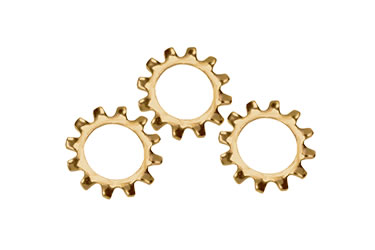
Locking washers are available in different styles. There are internal and external locking washers. They both feature teeth that allow them to bite into the surface with which they are used. The placement of these teeth, however, varies. What’s the difference between internal and external locking washers exactly?
What Are Internal Locking Washers?
Internal locking washers are characterized by the use of inward-facing teeth. Like most washers, they consist of ring-shaped pieces of metal. But the inner walls of internal locking washers aren’t smooth; they are serrated, resulting in inward-facing teeth. All internal locking washers have inward-facing teeth.
What Are External Locking Washers?
External locking washers, on the other hand, are characterized by the use of outward-facing teeth. They are similar to internal locking washers but with reversed teeth. External locking washers have a serrated perimeter as well. The serrations are found on the outside of external locking washers, though. You can see an example of external locking washers in the photo above.
Differences Between Internal and External Locking Washers
The main difference between internal and external locking washers is that the former have inward-facing teeth, whereas the latter have outward-facing teeth. They both have teeth. The teeth consist of serrations. On internal locking washers, you can find these teeth on the inner walls. On external locking washers, they are located on the exterior.
There are other differences between internal and external locking washers. Internal locking washers are able to bite into fasteners. They can specifically bite into the head of a screw or bolt, thereby holding the fastener in place.
External locking washers are better suited for biting into surfaces. They are typically larger than internal locking washers. With their larger size, they’ll cover more space. Internal locking washers may bite into some of the surrounding surface of an object, but most of their force will be placed upon the head of a fastener. External washers are larger, so they are able to create a stronger bite with the surrounding surface.
It’s important to note that locking washers are often used for grounding applications as well. If a lug needs to be grounded, it may be installed with a locking washer. Internal locking washers are typically used for grounding applications such as this. As previously mentioned, internal locking washers will bite into the head of a fastener. They’ll sink into the head of a lug to provide a safe conductive path for excess electricity.



